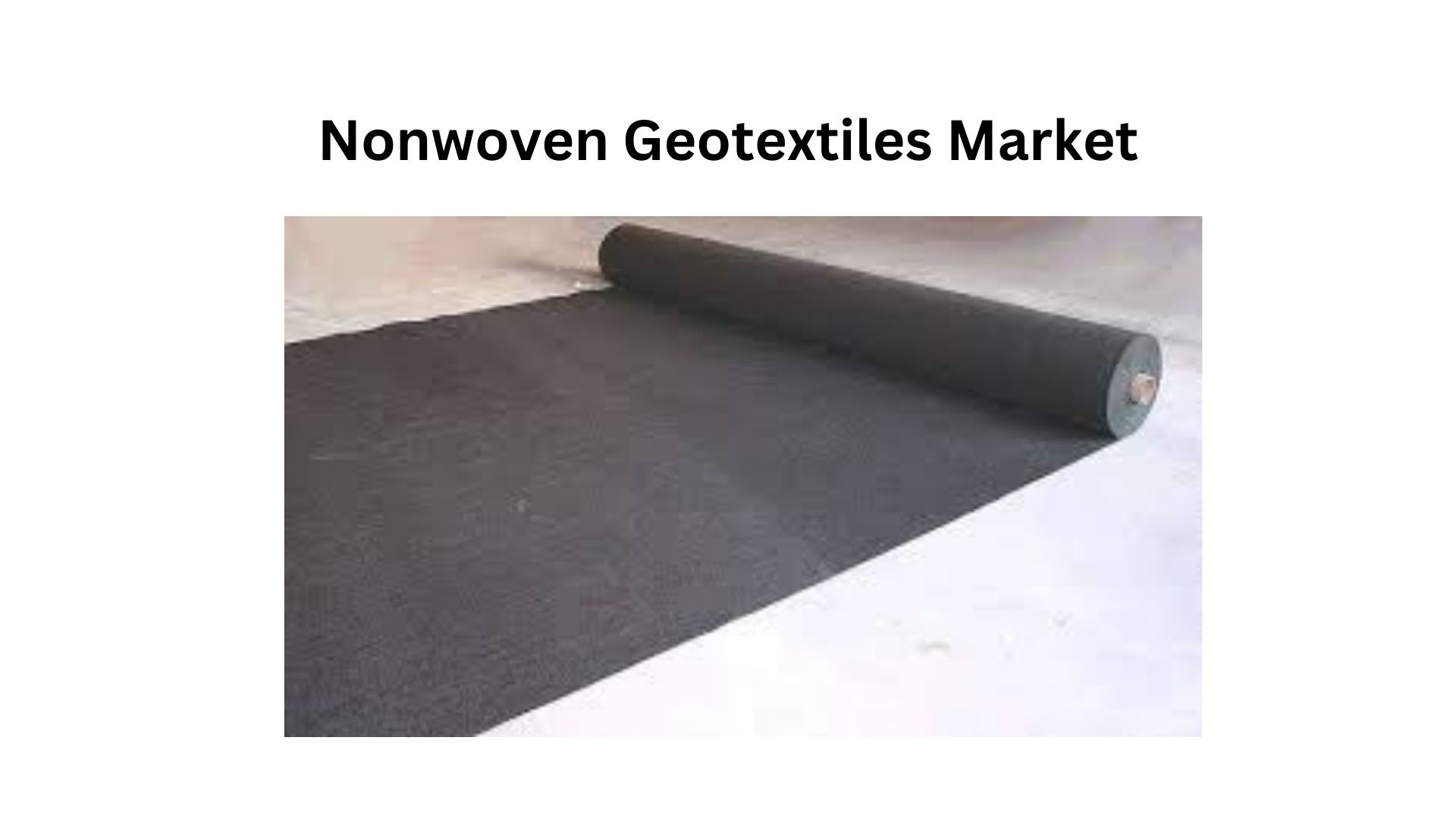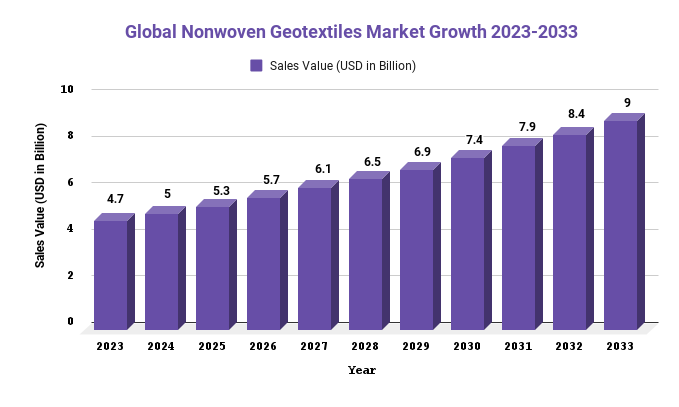Nonwoven Geotextiles Market is expected to reach USD 9.0 Bn by 2033 | CAGR of 6.7%

Page Contents
Market Overview
Published Via 11Press: Nonwoven geotextiles are fabrics composed of synthetic materials like polyester or polypropylene that find application in various civil engineering and environmental projects. Their high strength-to-weight ratio and superior filtration properties make them ideal for tasks such as erosion control, soil stabilization, drainage systems, and road construction. Over the past several years, the global nonwoven geotextiles market has witnessed steady growth due to factors such as rising infrastructure development and urbanization, growing environmental concerns, and an increasing need for cost-effective yet sustainable construction materials.
The Nonwoven Geotextiles Market size is expected to reach USD 9.0 Bn by 2033, up from its current value of USD 4.7 Bn in 2023, growing at an annual compound growth rate (CAGR) of 6.7% from 2023-2033.
Asia-Pacific is the leading market for nonwoven geotextiles, due to rapid infrastructure development and urbanization in countries like China and India. North America and Europe also play a significant role due to growing environmental awareness and the demand for sustainable construction materials.

Key Takeaways
- The nonwoven geotextiles market is experiencing rapid expansion due to increasing demand for geotextiles in various applications such as road construction, erosion control, and drainage systems. Furthermore, increased awareness about environmental concerns like soil erosion, land degradation, and water conservation is driving demand for nonwoven geotextiles.
- The expansion of infrastructure development activities such as highways, railways, and airports is predicted to drive demand for nonwoven geotextiles. Government regulations such as the Clean Water Act and Clean Air Act also anticipate driving this market demand in environmental protection applications. Asia Pacific region is expected to experience the highest growth in this market due to rising infrastructure development activities within this region.
Request For Sample Report Here: https://marketresearch.biz/report/nonwoven-geotextiles-market/request-sample/
Regional Snapshot
The nonwoven geotextiles market is a global market and is distributed across various regions of the world.
- North America: The North American nonwoven geotextile market is expected to witness growth due to increased interest in framework development and an increasing need for disintegration control and seepage frameworks in the region.
- Europe: The European nonwoven geotextiles market is expected to experience growth due to increasing development activities and an increasing interest in earth-friendly items in the region.
- Asia-Pacific: The Asia-Pacific nonwoven geotextiles market is expected to expand due to rising foundation improvement and an increasing need for disintegration control and soil adjustment in the region.
- Latin America: The Latin American nonwoven geotextile market is projected to expand due to rising interest in foundation improvement and an increasing need for development materials in the region.
- Center East and Africa: The nonwoven geotextile market in the Center East and Africa is expected to experience growth due to rising interest in developing materials and framework improvement projects within the region.
Enquire Here & Query for the report: https://marketresearch.biz/report/nonwoven-geotextiles-market/#inquiry
Drivers
- Nonwoven geotextiles are synthetic fabrics made from polypropylene, polyester, or other polymers and used in civil engineering, construction, and environmental sectors. Nonwoven geotextiles have many applications within construction such as drainage, filtration, separation, and erosion control. With the rapid growth in the global construction industry, demand for nonwoven geotextiles has also grown significantly.
- Infrastructure development is one of the primary drivers of demand in the nonwoven geotextiles market. Governments worldwide are investing heavily in infrastructure construction, which is expected to boost demand for nonwoven geotextiles in the coming years. Nonwoven geotextiles have many environmental applications such as landfills, erosion control, and soil stabilization – due to growing environmental concerns worldwide. With growing demands for nonwoven geotextiles, their popularity among marketers worldwide is on the rise.
- Technological advances have enabled the production of superior nonwoven geotextiles that offer improved performance and durability. As a result, demand for these geotextiles is on the rise across various applications. Nonwoven geotextiles offer cost-effective alternatives to traditional construction materials like concrete or asphalt, leading them to be widely adopted in road building, drainage systems, and erosion control applications. Emerging economies such as India, China, and Brazil are experiencing rapid urbanization and industrialization which will further fuel growth in this market over the coming years.
Restraints
- Limited Product Awareness: Nonwoven geotextiles may not be well-known in certain regions and may not be preferred over conventional construction materials. This could hinder the growth of the market, particularly in developing nations.
- Environmental Concerns: Nonwoven geotextiles are manufactured from synthetic materials, raising questions about their environmental impact. Consumers may prefer eco-friendly alternatives, which could limit market expansion.
- Cost: Nonwoven geotextiles tend to be more costly than conventional materials, which could limit their appeal in cost-sensitive markets.
- Competition from Other Materials: Nonwoven geotextiles are faced with competition from woven geotextiles, geomembranes, and geogrids that could limit their market share.
- Installation Challenges: Nonwoven geotextiles require specialized installation procedures and skilled labor, potentially increasing the overall cost and inhibiting market expansion.
- Alternative Materials Available: In some applications, alternative materials such as sandbags and rocks can be used instead of nonwoven geotextiles, potentially restricting the market growth.
Opportunities
- With the growing global infrastructure development demand, nonwoven geotextiles are in high demand. These materials can be utilized for road, highway, railway, and airport projects as well as erosion control, landfilling, and waste management – due to increased environmental awareness. Furthermore, nonwoven geotextiles have found applications in agriculture for weed control, soil stabilization, and drainage purposes; with food demand growing exponentially, there is also a promising potential within this sector too.
- Nonwoven geotextiles are widely used in the construction of water management systems such as dams, reservoirs, and canals. With an increasing demand for these materials around the world, nonwoven geotextiles have taken on new significance. Mining also relies on them for soil stabilization, drainage, and erosion control – an opportunity that nonwoven geotextiles are well positioned to take advantage of as minerals become scarcer globally. Nonwoven geotextiles continue to develop new products and applications which offer companies new markets as well as potential revenue streams.
Challenges
- Nonwoven geotextiles are competing against other geotextile materials like woven and knitted geotextiles, as well as nonwoven geogrids and geomembranes. This competition could limit demand for nonwoven geotextiles and reduce their market share. Nonwoven geotextiles are made from synthetic fibers such as polyester and polypropylene, so changes in the prices of these raw materials can have an impact on both production costs and market profitability. Nonwoven geotextiles are widely used in construction, civil engineering and other infrastructure projects. Unfortunately, their disposal after use presents a challenge as they are nonbiodegradable and contribute to environmental pollution. This has resulted in stricter environmental regulations which may reduce demand for nonwoven geotextiles.
- Nonwoven geotextiles are still a relatively new technology in some regions, and there is often a lack of awareness regarding their advantages and applications. This could limit the market potential for nonwoven geotextiles since potential customers may not be aware of their effectiveness for improving soil stability, preventing erosion, or other geotechnical uses. Furthermore, growth within this market is closely connected to economic conditions since many are used in infrastructure projects requiring significant investments; economic downturns can reduce project numbers significantly thus decreasing demand for nonwoven geotextiles.
Market Segmentation
Segmentation on the Basis of Material Type:
- Polypropylene
- Polyester
- Polyethylene
- Others (Rayon and Cotton)
Segmentation on the Basis of Technology:
- Spunbond Technology
- Meltblown Technology
- Air-laid Technology
- Needle-punch Technology
- Wet-laid Technology
- Composite
Segmentation on the Basis of Application:
- Road Construction
- Erosion Prevention
- Drainage
- Others (Medical, Railway Work, and Retaining Structures)
Key Players
- GSE Environmental
- Low & Bonar PLC
- Koninklijke Ten Cate
- Fibertex Nonwovens A/S
- Thrace Group
- HUESKER Synthetic GmbH
- Officine Maccaferri Spa
- Strata Systems, Inc.
- Leggett & Platt, Inc.
- Berry Global Inc.
Report Scope
| Report Attribute | Details |
| Market size value in 2023 | USD 4.7 Bn |
| Revenue forecast by 2033 | USD 9.0 Bn |
| Growth Rate | CAGR Of 6.7% |
| Regions Covered | North America, Europe, Asia Pacific, Latin America, and Middle East & Africa, and Rest of the World |
| Historical Years | 2017-2022 |
| Base Year | 2022 |
| Estimated Year | 2023 |
| Short-Term Projection Year | 2028 |
| Long-Term Projected Year | 2033 |
Recent Developments
- Nonwoven geotextiles are widely used in construction activities such as road construction, soil stabilization, erosion control and drainage systems. With the rising demand for infrastructure development worldwide, the nonwoven geotextiles market is expected to grow significantly. Manufacturers are investing heavily in research and development activities to enhance their performance; advances in technology have allowed for the creation of geotextiles with improved strength, durability, and permeability.
- Sustainable construction practices are fueling the demand for eco-friendly nonwoven geotextiles. Manufacturers are using recycled materials and biodegradable polymers to create these geotextiles with greater sustainability. Many key players in the nonwoven geotextile market are expanding production facilities to keep up with rising demand; Low & Bonar recently announced plans to expand its China facility in 2021 to serve the Asia-Pacific market.
Key Questions
1. What are nonwoven geotextiles?
Nonwoven geotextiles are synthetic fabrics made of polypropylene or other polymers used in civil engineering applications to improve soil performance through separation, filtration, drainage, and reinforcement.
2. What are the primary uses of nonwoven geotextiles?
Nonwoven geotextiles have numerous applications, such as road construction, drainage systems, erosion control, railway ballast, landfill liners and sediment control.
3. What Are the Advantages of Nonwoven Geotextiles?
Nonwoven geotextiles offer several benefits, such as high strength and durability, superior filtration properties, and resistance to chemicals and ultraviolet radiation. Furthermore, these cost-effective solutions offer budget-friendly options for civil engineering projects.
4. What are the major factors propelling growth in the nonwoven geotextiles market?
The primary factors driving growth in the nonwoven geotextile market include rising demand for these textiles in infrastructure development, growing awareness about their advantages, and increased investments within the construction sector.
5. What are the challenges confronting the nonwoven geotextiles market?
The nonwoven geotextiles market faces several obstacles, such as an absence of substitutes and insufficient awareness among end-users regarding their advantages when using geotextiles.
6. What are the major trends in the nonwoven geotextiles market?
Some of the key developments within this space include bio-based geotextiles, nanotechnology applications to enhance the performance of geotextiles, and the increasing adoption of geosynthetics in sustainable construction practices.
Contact us
Contact Person: Mr. Lawrence John
Marketresearch.Biz (Powered By Prudour Pvt. Ltd.)
Tel: +1 (347) 796-4335
Send Email: [email protected]
The team behind market.us, marketresearch.biz, market.biz and more. Our purpose is to keep our customers ahead of the game with regard to the markets. They may fluctuate up or down, but we will help you to stay ahead of the curve in these market fluctuations. Our consistent growth and ability to deliver in-depth analyses and market insight has engaged genuine market players. They have faith in us to offer the data and information they require to make balanced and decisive marketing decisions.